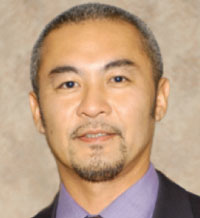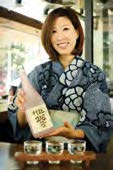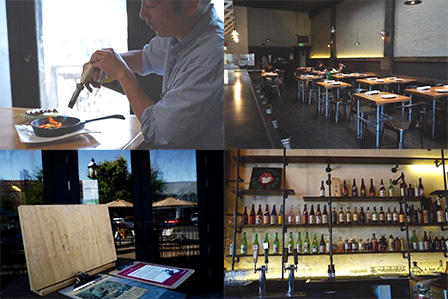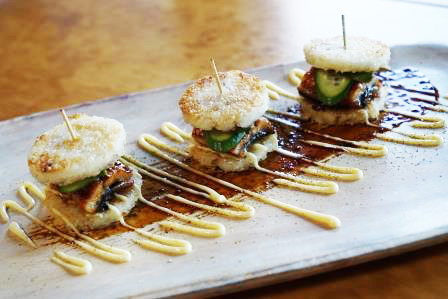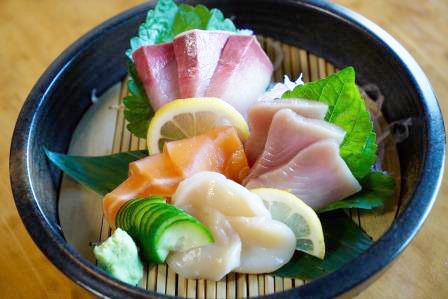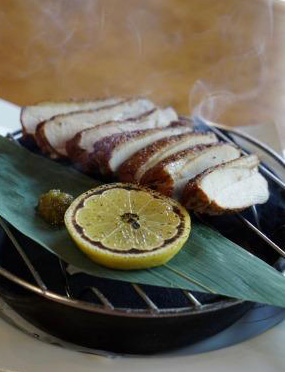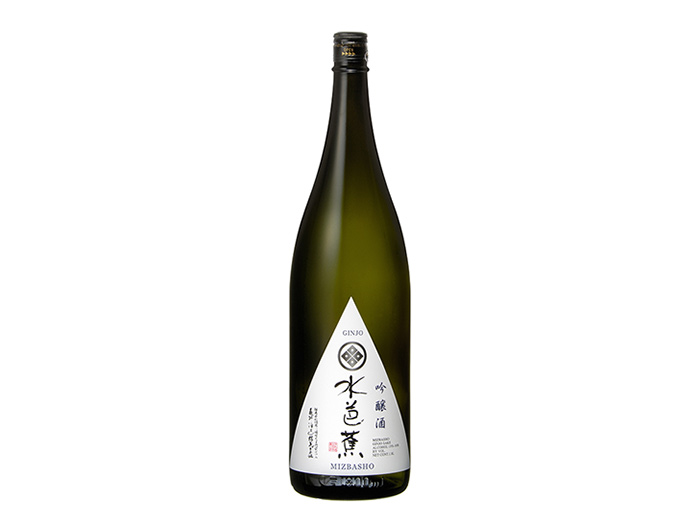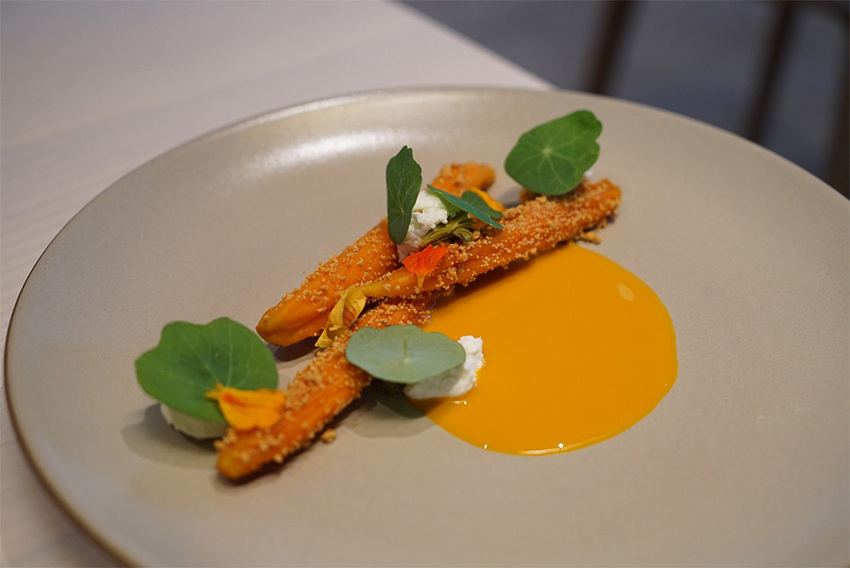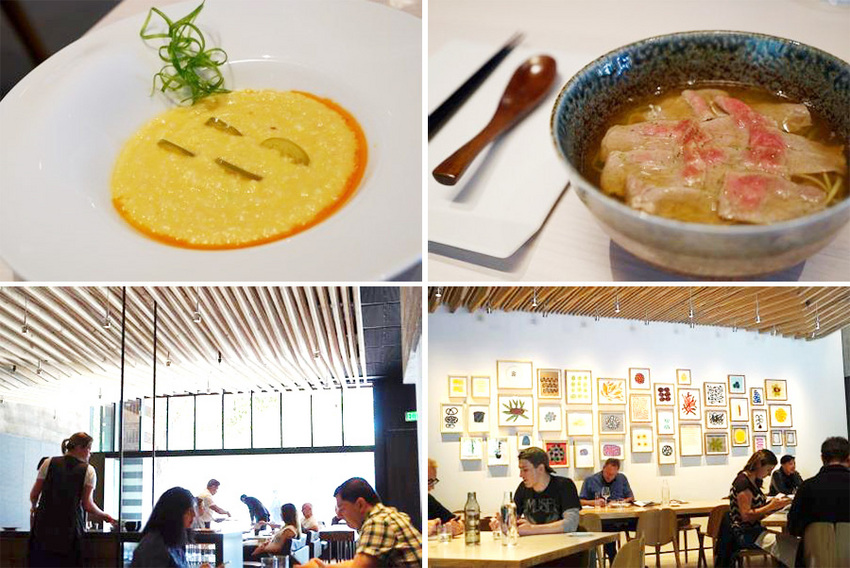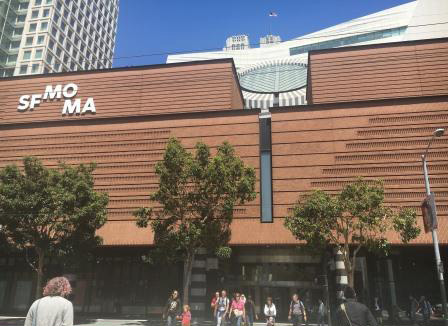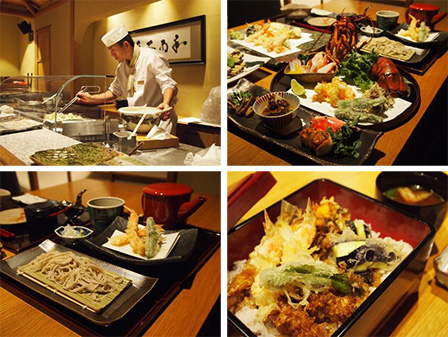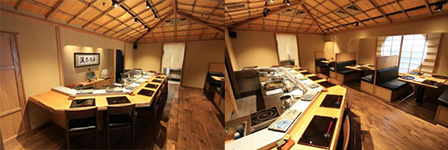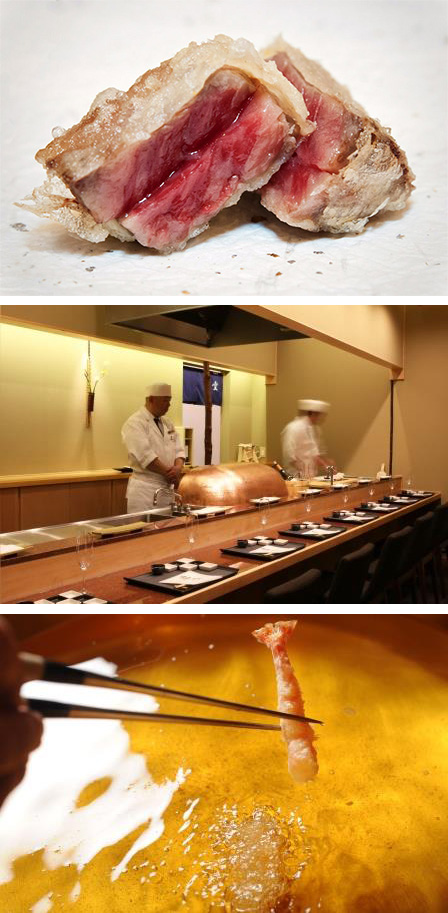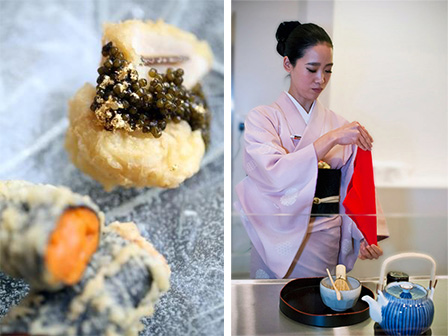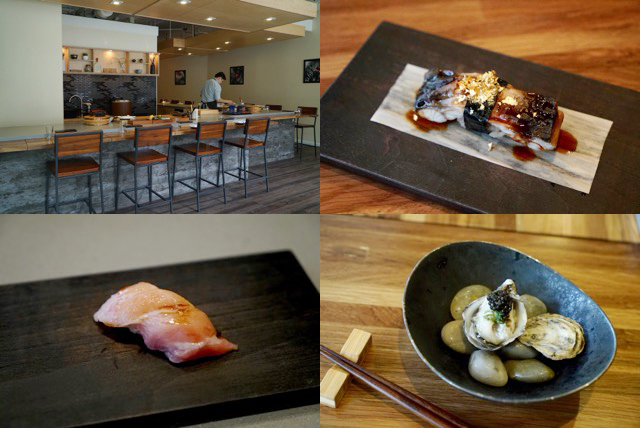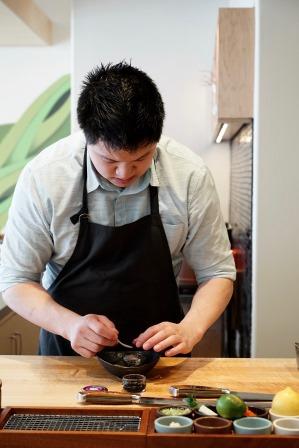Powerful new restaurant with “Smoke” theme is changing the town
By Elli Sekine
"Kemuri Japanese Baru”, a smoked dish specialty store opened in Silicon Valley. “Kemuri” means smoke in English.
The restaurant specializes in charcoal grilled dishes cooked with Binchotan charcoals, and smoked plates that are smoked sashimi and chicken and umami brought out by adding fragrances with cherry chips, etc. This new trendy restaurant, “Kemuri”, with a unique concept is leading the local Japanese food culture. Redwood City, where this restaurant resides, is a bed town in Silicon Valley. The city center used to be occupied with family restaurants, and was far from an image of a trendy city.
As the Silicon Valley grew bigger, and so did its population, there has been a housing onstruction rush of condominiums and apartment buildings for as many as 30,000 growing residents. Redwood City is becoming a favorite residential town for its convenient location being between San Jose and San Francisco, having a train station, and easy access to freeways. “Kemuri” is located on the main street. It stands out amongst the other Japanese restaurants in the neighborhood which serve usual sushi and teriyaki types of dishes. The locals see “Kemuri” as an unusual spot where they can experience trendy Japanese cuisine and talk a lot about it. Along with the population growth, IT business people started to come to this town and hang out at bars after work in the evening.
Those crowds are really changing the atmosphere of this town. The person who grabbed the business chance in this district where Japanese cuisine is developing is Takeo Moriyama, the owner/chef of “Kemuri” who is managing a restaurant for the first-time. “I chose this town because I saw a future. He says, “I would rather serve delicious dishes that are locally developed than insisting on the traditional style.” He never had any professional training or attending cooking school. He got into the food industry just because he had always liked cooking ever since he was a young child. He obtained permanent US residency by winning the lottery program in his twenties, and came to the U.S. His first job was working in the kitchen of a restaurant in San Jose called “Gaku”. His passion for cooking gradually grew there. He kept experimenting and studying by himself, and the home cooking menu he created with a keen sense became very popular, and led “Gaku” to become a very popular restaurant at the same time.
He opened this new restaurant “Kemuri” after going through such a success.
Smoking is profound. In order to bring out the best umami, some like yakitori are broiled, and some like fish and meat are smoked with wooden chips. Depending on the ingredients, proper adjusting of flames, amount of smoke, temperature control, etc., is required. The high-quality Binchotan charcoal from Japan can be heated as high as 800 degrees. Infrared rays and high heat radiated from the charcoal bring out umami, and result in crispy outside, fluffy inside, and juicy finish.
The recommended dish is the “Chicken Thigh ($8)”, “Beef Tongue ($16)” which uses tender center cut, “Salmon Toro Aburi ($15)”, etc. Their signature dish is the “Smoked Sashimi ($25)” which is raw fish slightly smoked to bring out the sweetness. The popular appetizer is the “Unagi Slider ($12)” which is unagi sandwiched in toasted rice patties. The flavorfully grilled unagi is juicy, and the accompanying crispy cucumber slices are refreshing. ”Ox-tail Udon ($14) with Inaniwa udon is good to complete the meal with, and the “Washu Beef and Foie Gras ($35), or “Omakase” are good for gourmet eaters. They can be pre-ordered.
Another charm of this place is a large full-service bar. The drink menu is rich, especially the Japanese whiskeys. There are over 17 different brands. No other restaurants carry this many. Some of them are rare brands such as Hibiki 21 years, Yamazaki 18 years, and Yoichi 15 years, which are difficult to get even in Japan. Cocktails made with spirits such as the “Kemuri Smoked Manhattan ($14 and the “Shiso Wasabi Margarita ($12)” are popular signature drinks. Shochu and sake from each prefecture are lined up as well. They have outdoor seating to enjoy happy hour.
They sometimes host events such as beer pairing with sashimi, and sake festivals, etc. As you know, Steve Jobs loved Japanese cuisine. Relations between the development of Silicon Valley and Japanese cuisine has become inseparable. Evolving Japanese cuisine in the American way can be possible only by this skillful chef who can perform charcoal magic by polishing the “Yaki” skill which is the basic of Japanese cuisine.
I felt the town breathing with the new wind created by this new powerful cutting- edge skilled owner/chef.
「炭火料理」をテーマにした新鋭レストランが街を変える
「Kemuri Japanese Baru」という”煙”をテーマにした料理の店がシリコンバレーにオープンした。店名の“kemuri” とは英語でSmokeの意味。同店では備長炭を使った炭火料理と刺身や鶏料理にチェリーのチップなどでスモーキーな香りを付け素材の旨味を引き出し香りをつける燻製料理を主体としている。このユニークなコンセプトを持つ「Kemuri」が地元の日本食トレンドをリードしている。
同店が存在する レッドウッドシティは、シリコンバレーのほぼ中心に位置するベットタウン。街の中心部はファミリー向けのレストランが多数を占め、最近までトレンドには縁遠いイメージだった。 しかしシリコンバレーの発展に伴い人口が急増し、最近では約3万人の移住者を受け入れるコンドやアパートの建設ラッシュが続いている。サンフランシスコとサンノゼを繋ぐ電車の駅が街に乗り入れ、フリーウェイにも近いことから居住区としての人気急上昇中だ。人口増加と共にIT関連のビジネス客が流れてくるようになり、仕事が終わる夕方になると周りの人気のバーにも人があふれ、人の活気が街全体の様相を変えている。
「Kemuri」は、周りにある昔ながらの寿司に照り焼きを中心とする日本食レストランに比べるとひと際目立ち、地元住民にとって寿司以外の日本食トレンドを体験できるスポットとして話題になっている。
この日本食の発展途上地区にビジネスチャンスを見出したのは、今回初のレストラン経営に挑む「Kemuri」 のオーナーシェフ、森山岳男氏。「この街の将来性を期待して場所を選びました。伝統にこだわるより現地で進化させた美味しい料理を提供したいです」と語る同氏は、料理学校やレストランでの修行の経験はなく、子供の頃から調理は好きだったという程度の動機でレストラン業界に入った。20代で永住権抽選プログラムにより永住権を取得し渡米。初めに働いたサンノゼのレストラン「GAKU」の調理場での経験が次第にパッションになっていった。独自に研究を重ね、鋭い感性で創作した家庭料理風メニューが好評を得、同時に「GAKU」も人気店となった。そしてその経験を経て今回開業に至った。
炭火料理は奥が深い。焼き鳥のように仕上げる「炙り」とチップを使い肉や魚を燻してフレーバーをつける「燻製」を食材により火加減やスモークする煙の量、温度を細かく調整し旨味を引き出す。日本から取り寄せた高品質の備長炭は800度まで温度を上げる事ができる。
炭から発生する赤外線と高温により旨味が引き出されるため、外がパリパリで中がフワフワ、ジューシーな仕上がりになる。おすすめはChicken Thigh ($8)、芯の柔らかい部位を使ったBeef Tongue($16)、 Salmon Salmon Tro Aburi ($15)など。冷燻製から生魚を少し燻して甘みを引き出した燻製刺身$25は看板メニューとなっている。アペタイザーからの人気メニューは、焼きおにぎりのように表面を焦がしたライスにうなぎをサンドしたUnagi Slider ($12)。ジューシーに焼き上げた香ばしいうなぎに歯ごたえが良い新鮮なきゅうりが斬新だ。
シメには稲庭うどんスタイルのOx-tailudon($14)、グルメの客には、Washu Beef and Foie Gras( $35)や「オマカセ」もプリオーダーできる。
同店のもう一つの魅力は、広い本格的なフルバーだ。ドリンクメニューも豊富で、特に日本ウィスキーの品揃えは他のレストランに比べダントツで、17種類を揃える。中には響21年、山崎18年、余市15年など日本でも入手困難なプレミアムもある。その他スピリッツで作るカクテルも人気でスモーキー味の「Kemuri Smoked Manhattan」($14)と「Shiso Wasabi Margarita」($12) は同店の看板料理。焼酎、日本酒も各県からの銘酒がずらりとラインアップ。外にはテラスもありハッピーアワーも楽しめる。またビールに合う刺身を創作したビールペアリングや酒祭りなどのイベントも開催している。
かつてスティーブ・ジョブスが日本食好き知られるように、シリコンバレーの発展と日本食の結びつきは密接不可分な存在になっている。–––日本食をアメリカ流に進化させていく–––それは日本食の基礎である「焼き」の技術を磨き、炭マジックを操れるシェフだから成しえることだ。この新進気鋭の若手オーナーがもたらす新風に街の息吹を感じた。
Kemuri
2616 Broadway
Redwood City, CA 94063
(650) 257-7653
http://kemuri-baru.com/
Lunch
Tues.-Fri./ 11:30am-2:00pm
Dinner
Tues.-Thur./ 5:30pm-10:00pm
Fri., Sat./ 5:00pm-11:00pm
Sun./ 5:00pm-9:30pm
Monday Closed
"Kemuri Japanese Baru”, a smoked dish specialty store opened in Silicon Valley. “Kemuri” means smoke in English.
The restaurant specializes in charcoal grilled dishes cooked with Binchotan charcoals, and smoked plates that are smoked sashimi and chicken and umami brought out by adding fragrances with cherry chips, etc. This new trendy restaurant, “Kemuri”, with a unique concept is leading the local Japanese food culture. Redwood City, where this restaurant resides, is a bed town in Silicon Valley. The city center used to be occupied with family restaurants, and was far from an image of a trendy city.
As the Silicon Valley grew bigger, and so did its population, there has been a housing onstruction rush of condominiums and apartment buildings for as many as 30,000 growing residents. Redwood City is becoming a favorite residential town for its convenient location being between San Jose and San Francisco, having a train station, and easy access to freeways. “Kemuri” is located on the main street. It stands out amongst the other Japanese restaurants in the neighborhood which serve usual sushi and teriyaki types of dishes. The locals see “Kemuri” as an unusual spot where they can experience trendy Japanese cuisine and talk a lot about it. Along with the population growth, IT business people started to come to this town and hang out at bars after work in the evening.
Those crowds are really changing the atmosphere of this town. The person who grabbed the business chance in this district where Japanese cuisine is developing is Takeo Moriyama, the owner/chef of “Kemuri” who is managing a restaurant for the first-time. “I chose this town because I saw a future. He says, “I would rather serve delicious dishes that are locally developed than insisting on the traditional style.” He never had any professional training or attending cooking school. He got into the food industry just because he had always liked cooking ever since he was a young child. He obtained permanent US residency by winning the lottery program in his twenties, and came to the U.S. His first job was working in the kitchen of a restaurant in San Jose called “Gaku”. His passion for cooking gradually grew there. He kept experimenting and studying by himself, and the home cooking menu he created with a keen sense became very popular, and led “Gaku” to become a very popular restaurant at the same time.
He opened this new restaurant “Kemuri” after going through such a success.
Smoking is profound. In order to bring out the best umami, some like yakitori are broiled, and some like fish and meat are smoked with wooden chips. Depending on the ingredients, proper adjusting of flames, amount of smoke, temperature control, etc., is required. The high-quality Binchotan charcoal from Japan can be heated as high as 800 degrees. Infrared rays and high heat radiated from the charcoal bring out umami, and result in crispy outside, fluffy inside, and juicy finish.
The recommended dish is the “Chicken Thigh ($8)”, “Beef Tongue ($16)” which uses tender center cut, “Salmon Toro Aburi ($15)”, etc. Their signature dish is the “Smoked Sashimi ($25)” which is raw fish slightly smoked to bring out the sweetness. The popular appetizer is the “Unagi Slider ($12)” which is unagi sandwiched in toasted rice patties. The flavorfully grilled unagi is juicy, and the accompanying crispy cucumber slices are refreshing. ”Ox-tail Udon ($14) with Inaniwa udon is good to complete the meal with, and the “Washu Beef and Foie Gras ($35), or “Omakase” are good for gourmet eaters. They can be pre-ordered.
Another charm of this place is a large full-service bar. The drink menu is rich, especially the Japanese whiskeys. There are over 17 different brands. No other restaurants carry this many. Some of them are rare brands such as Hibiki 21 years, Yamazaki 18 years, and Yoichi 15 years, which are difficult to get even in Japan. Cocktails made with spirits such as the “Kemuri Smoked Manhattan ($14 and the “Shiso Wasabi Margarita ($12)” are popular signature drinks. Shochu and sake from each prefecture are lined up as well. They have outdoor seating to enjoy happy hour.
They sometimes host events such as beer pairing with sashimi, and sake festivals, etc. As you know, Steve Jobs loved Japanese cuisine. Relations between the development of Silicon Valley and Japanese cuisine has become inseparable. Evolving Japanese cuisine in the American way can be possible only by this skillful chef who can perform charcoal magic by polishing the “Yaki” skill which is the basic of Japanese cuisine.
I felt the town breathing with the new wind created by this new powerful cutting- edge skilled owner/chef.
「炭火料理」をテーマにした新鋭レストランが街を変える
「Kemuri Japanese Baru」という”煙”をテーマにした料理の店がシリコンバレーにオープンした。店名の“kemuri” とは英語でSmokeの意味。同店では備長炭を使った炭火料理と刺身や鶏料理にチェリーのチップなどでスモーキーな香りを付け素材の旨味を引き出し香りをつける燻製料理を主体としている。このユニークなコンセプトを持つ「Kemuri」が地元の日本食トレンドをリードしている。
同店が存在する レッドウッドシティは、シリコンバレーのほぼ中心に位置するベットタウン。街の中心部はファミリー向けのレストランが多数を占め、最近までトレンドには縁遠いイメージだった。 しかしシリコンバレーの発展に伴い人口が急増し、最近では約3万人の移住者を受け入れるコンドやアパートの建設ラッシュが続いている。サンフランシスコとサンノゼを繋ぐ電車の駅が街に乗り入れ、フリーウェイにも近いことから居住区としての人気急上昇中だ。人口増加と共にIT関連のビジネス客が流れてくるようになり、仕事が終わる夕方になると周りの人気のバーにも人があふれ、人の活気が街全体の様相を変えている。
「Kemuri」は、周りにある昔ながらの寿司に照り焼きを中心とする日本食レストランに比べるとひと際目立ち、地元住民にとって寿司以外の日本食トレンドを体験できるスポットとして話題になっている。
この日本食の発展途上地区にビジネスチャンスを見出したのは、今回初のレストラン経営に挑む「Kemuri」 のオーナーシェフ、森山岳男氏。「この街の将来性を期待して場所を選びました。伝統にこだわるより現地で進化させた美味しい料理を提供したいです」と語る同氏は、料理学校やレストランでの修行の経験はなく、子供の頃から調理は好きだったという程度の動機でレストラン業界に入った。20代で永住権抽選プログラムにより永住権を取得し渡米。初めに働いたサンノゼのレストラン「GAKU」の調理場での経験が次第にパッションになっていった。独自に研究を重ね、鋭い感性で創作した家庭料理風メニューが好評を得、同時に「GAKU」も人気店となった。そしてその経験を経て今回開業に至った。
炭火料理は奥が深い。焼き鳥のように仕上げる「炙り」とチップを使い肉や魚を燻してフレーバーをつける「燻製」を食材により火加減やスモークする煙の量、温度を細かく調整し旨味を引き出す。日本から取り寄せた高品質の備長炭は800度まで温度を上げる事ができる。
炭から発生する赤外線と高温により旨味が引き出されるため、外がパリパリで中がフワフワ、ジューシーな仕上がりになる。おすすめはChicken Thigh ($8)、芯の柔らかい部位を使ったBeef Tongue($16)、 Salmon Salmon Tro Aburi ($15)など。冷燻製から生魚を少し燻して甘みを引き出した燻製刺身$25は看板メニューとなっている。アペタイザーからの人気メニューは、焼きおにぎりのように表面を焦がしたライスにうなぎをサンドしたUnagi Slider ($12)。ジューシーに焼き上げた香ばしいうなぎに歯ごたえが良い新鮮なきゅうりが斬新だ。
シメには稲庭うどんスタイルのOx-tailudon($14)、グルメの客には、Washu Beef and Foie Gras( $35)や「オマカセ」もプリオーダーできる。
同店のもう一つの魅力は、広い本格的なフルバーだ。ドリンクメニューも豊富で、特に日本ウィスキーの品揃えは他のレストランに比べダントツで、17種類を揃える。中には響21年、山崎18年、余市15年など日本でも入手困難なプレミアムもある。その他スピリッツで作るカクテルも人気でスモーキー味の「Kemuri Smoked Manhattan」($14)と「Shiso Wasabi Margarita」($12) は同店の看板料理。焼酎、日本酒も各県からの銘酒がずらりとラインアップ。外にはテラスもありハッピーアワーも楽しめる。またビールに合う刺身を創作したビールペアリングや酒祭りなどのイベントも開催している。
かつてスティーブ・ジョブスが日本食好き知られるように、シリコンバレーの発展と日本食の結びつきは密接不可分な存在になっている。–––日本食をアメリカ流に進化させていく–––それは日本食の基礎である「焼き」の技術を磨き、炭マジックを操れるシェフだから成しえることだ。この新進気鋭の若手オーナーがもたらす新風に街の息吹を感じた。
Kemuri
2616 Broadway
Redwood City, CA 94063
(650) 257-7653
http://kemuri-baru.com/
Lunch
Tues.-Fri./ 11:30am-2:00pm
Dinner
Tues.-Thur./ 5:30pm-10:00pm
Fri., Sat./ 5:00pm-11:00pm
Sun./ 5:00pm-9:30pm
Monday Closed

